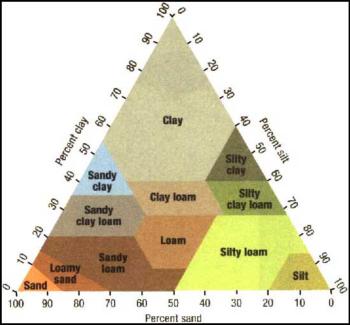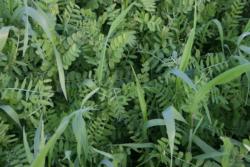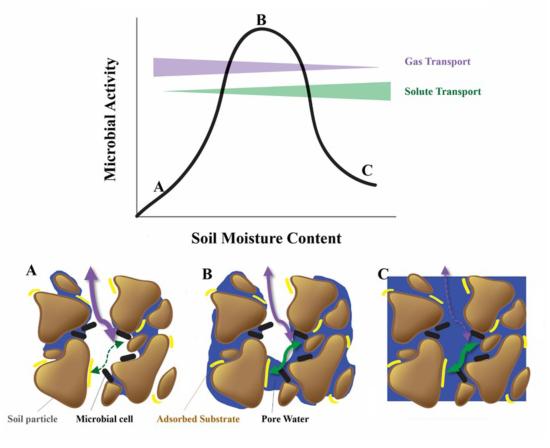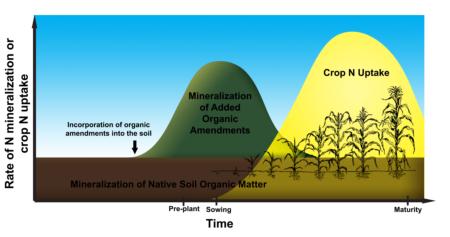Organic Nitrogen Availability
Introduction
Soils have an innate ability to supply crops with plant-available nitrogen throughout a growing season, a process known as nitrogen (N) mineralization. This supply of plant-available N comes from soil microbes decomposing organic matter into ammonium (NH4+), which is then quickly transformed into nitrate (NO3-) via nitrification. These forms of nitrogen (NH4+ and NO3-) are the preferred forms of nitrogen for plant uptake. However, the challenge to growers is how best to synchronize plant uptake with both the rate and timing of N mineralization from organic amendments, in order to gain maximum possible benefit for crop yield. Click the graphic at left to explore the factors that affect the mineralization of organic N sources in soil.
*Interactive diagram created in MapsAlive
Mineralization of Native Soil Organic Matter
Texture

Total Soil Nitrogen Content
A higher total soil N content results in higher N mineralization rates 5. However, since soil N content is related to soil organic matter content, it is not a fixed characteristic of a soil. You can increase your total soil N content through continuous inputs of organic materials, although it takes several years for the benefits to be apparent 6.
Mineralization of Added Organic Amendments
Rate of Application
In general, high rates of application will result in higher rates of N mineralization. However, if the main goal is to increase mineralization rates in the near future, it is suggest to avoid amendments with a high ratio of C to N. Such amendments will initially immobilize nitrogen, which effectively results in negative N mineralization 7.
Type of Organic Amendment

For cover crops, the availability of the N will vary, but conversion factors have been calculated to estimate their mineralization into plant-available nitrogen.
Soil Temperature
An increase in soil temperature increases biological activity9 which, in turn, increases the N mineralization rate of incorporated organic materials. This effect is small at soil temperatures less than 90°F, but then increases dramatically up to 105°F10. Although there are significant differences in soil temperature across the state, soil temperatures are usually less than 90°F. However, when temperature is coupled with soil moisture, you can see rates more than double at optimal moisture contents11, which are discussed below.

Soil Moisture Content
Nitrogen mineralization rates will generally increase as soil moisture increases11. This is due to a redistribution of organic materials throughout the soil, which makes them available to more soil microbes to be mineralized12. Although the N mineralization rate plateaus after it reaches this optimum moisture content13, saturated conditions encourage denitrification. Denitrification will occur due to decreased transport of gases (i.e. oxygen), which encourages anaerobic conditions and increased production of nitrous oxide. Therefore, to maximize mineralization and minimize losses, soil moisture should be kept in a “sweet spot”, as illustrated in the figure to the left. This optimal moisture content, where the N mineralization rate begins to plateau, will vary according to soil texture, structure, and aggregation and is therefore difficult to standardize using straightforward measures of soil moisture content13.
References
1 Colman, B. P., & Schimel, J. P. (2013). Drivers of microbial respiration and net N mineralization at the continental scale. Soil Biology and Biochemistry, 60, 65-76.
2 Parton, W. J., Schimel, D. S., Cole, C. V., & Ojima, D. S. (1987). Analysis of factors controlling soil organic matter levels in Great Plains grasslands. Soil Science Society of America Journal, 51(5), 1173-1179.
3 Burke, I. C., Yonker, C. M., Parton, W. J., Cole, C. V., Schimel, D. S., & Flach, K. (1989). Texture, climate, and cultivation effects on soil organic matter content in US grassland soils. Soil science society of America journal, 53(3), 800-805.
4 Mikutta, R., & Kaiser, K. (2011). Organic matter bound to mineral surfaces: resistance to chemical and biological oxidation. Soil Biology and Biochemistry, 43(8), 1738-1741.
5 Hartz, T. K., Bendixen, W. E., & Wierdsma, L. (2000a). The value of presidedress soil nitrate testing as a nitrogen management tool in irrigated vegetable production. HortScience, 35(4), 651-656.
6 Kramer, A. W., Doane, T. A., Horwath, W. R., & van Kessel, C. (2002). Short-term nitrogen-15 recovery vs. long-term total soil N gains in conventional and alternative cropping systems. Soil Biology and Biochemistry, 34(1), 43-50.
7 Geisseler, D., Horwath, W. R., & Doane, T. A. (2009). Significance of organic nitrogen uptake from plant residues by soil microorganisms as affected by carbon and nitrogen availability. Soil Biology and Biochemistry, 41(6), 1281-1288.
8 Hartz, T. K., Mitchell, J. P., & Giannini, C. (2000b). Nitrogen and carbon mineralization dynamics of manures and composts. HortScience, 35(2), 209-212.
9 Cookson, W. R., Osman, M., Marschner, P., Abaye, D. A., Clark, I., Murphy, D. V., Stockdale, E.A., & Watson, C. A. (2007). Controls on soil nitrogen cycling and microbial community composition across land use and incubation temperature. Soil Biology and Biochemistry, 39(3), 744-756.
10 Hoyle, F. C., Murphy, D. V., & Fillery, I. R. P. (2006). Temperature and stubble management influence microbial CO 2–C evolution and gross N transformation rates. Soil Biology and Biochemistry, 38(1), 71-80.
11 Goncalves, J. L. M., & Carlyle, J. C. (1994). Modelling the influence of moisture and temperature on net nitrogen mineralization in a forested sandy soil. Soil Biology and Biochemistry, 26(11), 1557-1564.
12 Moyano, F. E., Manzoni, S., & Chenu, C. (2013). Responses of soil heterotrophic respiration to moisture availability: An exploration of processes and models. Soil Biology and Biochemistry, 59, 72-85.
13 Paul, K. I., Polglase, P. J., O'Connell, A. M., Carlyle, J. C., Smethurst, P. J., & Khanna, P. K. (2003). Defining the relation between soil water content and net nitrogen mineralization. European Journal of Soil Science, 54(1), 39-48.

